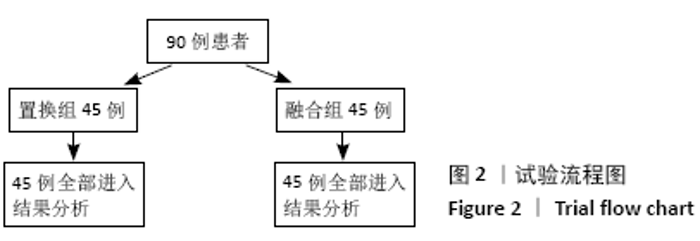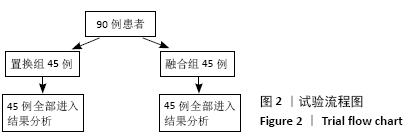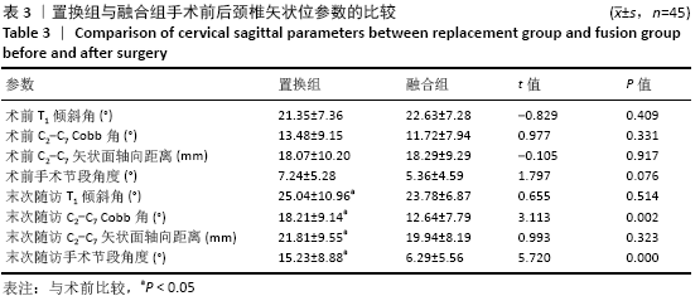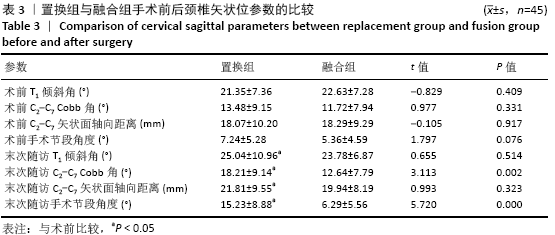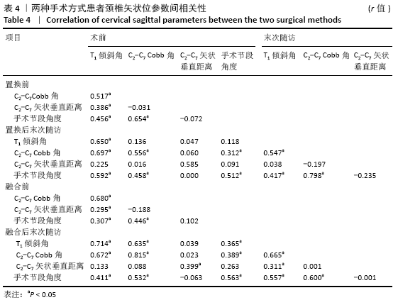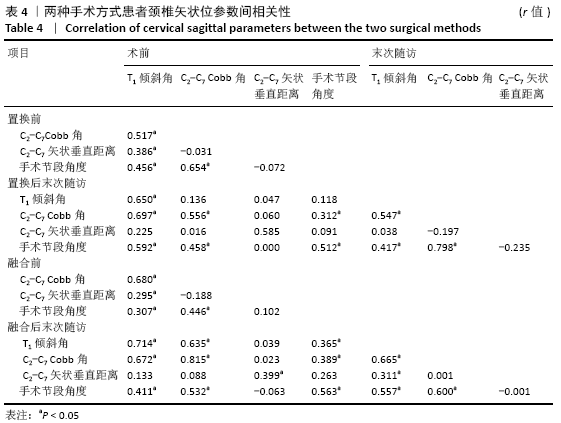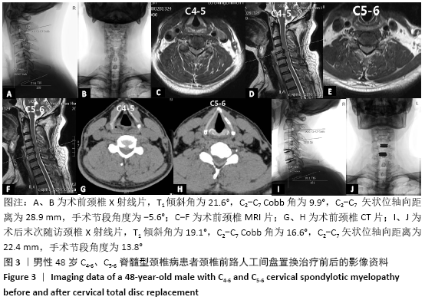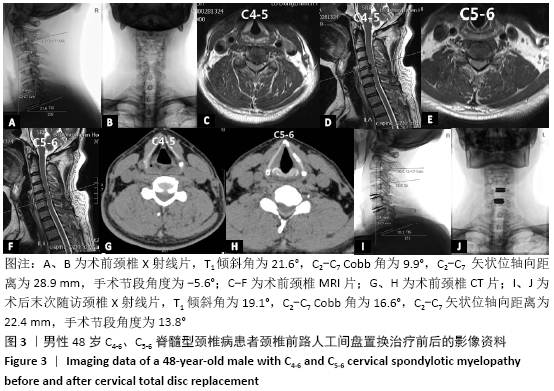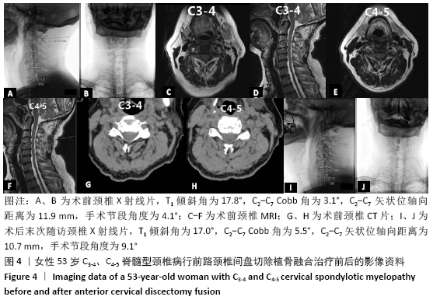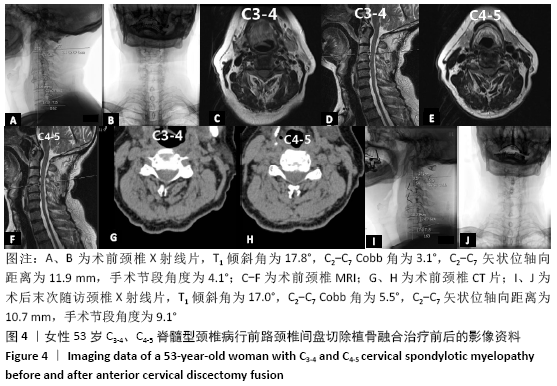[1] DI MARTINO A, PAPALIA R, ALBO E, et al. DenaroCervical spine alignment in disc arthroplasty: should we change our perspective? Eur Spine J. 2015;24(Suppl. 7):S810-S825.
[2] GANDHI AA, KODE S, DEVRIES NA, et al. FredericksBiomechanical analysis of cervical disc replacement and fusion using single level, two level, and hybrid constructs. Spine (Phila Pa 1976). 2015;(40): 1578-1585.
[3] PATWARDHAN AG, KHAYATZADEH S, HAVEY RM, et al. Cervical sagittal balance: a biomechanical perspective can help clinical practice. Eur Spine J. 2018;27(Suppl 1):25-38.
[4] 田伟.积水潭实用骨科学[M].北京:人民卫生出版社,2008:528.
[5] 黎庆初,张忠民,尹刚辉,等.自锁式颈椎融合器在多节段脊髓型颈椎病中的应用[J].中华外科杂志,2012,50(9):818-822.
[6] WANG ZL, XIAO JL, MOU JH, et al. Analysis of cervical sagittal balance parameters in MRIs of patients with disc-degenerative disease. Med Sci Monit. 2015;21(10):3083-3088.
[7] TIAN W, YAN K, HAN X, et al. Comparison of the clinical and radiographic results between cervical artificial disk replacement and anterior cervical fusion: a 6-year prospective nonrandomized comparative study. Clin Spine Surg. 2017;30(5):578-586.
[8] TIAN W, WANG H, YAN K, et al. Analysis of the factors that could predict segmental range of motion after cervical artificial dis creplacement: a 7 years follow up study. Clin Spine Surg. 2017;30(5):603-608.
[9] 章戈,张亚中,郑培炎,等.Mobi-C人工颈椎间盘置换术与ROI-C辅助的颈椎前路减压融合术治疗单节段颈椎病的临床研究[J].实用骨科杂志,2019,25(6):481-487,504.
[10] SENG C, TOW BPB, SIDDIQUI MA, et al. Surgically treated cervical myelopathy: a functional outcome comparison study between multilevel anterior cervical decompression fusion with instrumentation and posterior laminoplasty. Spine J. 2013;13(7):723-731.
[11] GRASSO G, GIAMBARTINO F, TOMASELLO G, et al. Anterior cervical discectomy and fusion with ROI-C peek cage: cervical alignment and patient outcomes. Eur Spine J. 2014;23(Suppl 6 ):650-657.
[12] SUN Y, LI L, ZHAO J, et al. Comparison between anterior approaches and posterior approaches for the treatment of multilevel cervical spondylotic myelopathy: A meta-analysis. Clin Neurol Neurosurg. 2015;134(4):28-36.
[13] LIU W, FAN J, BAI J, et al. Magnetic resonance imaging: A possible alternative to a standing lateral radiograph for evaluating cervical sagittal alignment in patients with cervical disc herniation? Medicine (Baltimore). 2017;96(39):e8194.
[14] 缪健荣,周志平,田守进,等.传统钛板加Cage与ROI-C治疗颈椎病术后矢状位参数的变化[J].南京医科大学学报(自然科学版), 2018,38(11):1572-1575.
[15] 李国闯,丁昌懋,宋瑞鹏,等.颈椎矢状位序列在站立位与平卧位测定中的差异及临床意义[J].医药论坛杂志,2019,40(4):18-21.
[16] SASAKI T, KADOYA S, IIZUKA H. Roentgenological study of the sagittal diameter of the cervical spinal canal in normal adult Japanese. Neurol Med Chir (Tokyo). 1998;38:83-89.
[17] PARK JH, CHO CB, SONG JH, et al. T1 Slope and Cervical Sagittal Alignment on Cervical CT Radiographs of Asymptomatic Persons. J Korean Neurosurg Soc. 2013;53(6):356-359.
[18] YAMAHATA H, SUGATA J, MORI M, et al. Measurement of Cervical Sagittal Alignment Parameters on X-Ray Films of Adults without Severe Spinal Deformity Whose Shoulder Hides the Lower Cervical Column. World Neurosurg. 2019;121(1):E147-E153.
[19] JUN HS, CHANG IB, SONG JH, et al. Is it possible to evaluate the parameters of cervical sagittal alignment on cervicacomputed tomographic scans? Spine (Phila P1976). 2014;39:E630-E636.
[20] 吴涛,刘军,王刚.X射线、CT、MRI评估C_7椎体显示不清颈椎退变性疾病C_(2-7)Cobb角的可靠性[J].中国组织工程研究,2018, 22(31):4993-4997.
[21] 张浩,周文超,陈元元,等.颈椎后纵韧带骨化症单开门椎管扩大成形术后颈椎矢状位参数变化与疗效的关系[J].中国脊柱脊髓杂志,2016,26(3):206-210.
[22] JANG JS, LEE SH, MIN JH, et al. Surgical treatment of failed back surgery syndrome due to sagittal imbalance. Spine (Phila P1976). 2007;32(26): 3081-3087.
[23] YEH KT, YU TC, CHEN IH, et al. Expansive open-door laminoplasty secured with titanium miniplates is a good surgical method for multiple-level cervical stenosis. J Orthop Surg Res. 2014;9:49.
[24] LU J, SUN C, BAI J, et al. Is Correction of segmental kyphosis necessary in single-level anterior cervical fusion surgery? An observational study. Ther Clin Risk Manag. 2018;19(9):15:39-44.
[25] 福嘉欣,江毅,江汉,等.T1斜坡角度与颈后路单开门椎管扩大成形术后颈椎曲度变化关系的探讨[J].中国矫形外科杂志,2015, 23(15):1360-1364.
[26] KNOTT PT, MARDJETKO SM, TECHY F. The use of the T1 sagittal angle in predicting overall sagittal balance of the spine. Spine J. 2010;10(11): 994-998.
[27] XING R, LIU W, LI X, et al. Characteristics of cervical sagittal parameters in healthy cervical spine adults and patients with cervical disc degeneration. BMC Musculoskelet Disord. 2018;19(1): 37.
[28] LEE SH, KIM KT, SEO EM, et al. The Influence of Thoracic Inlet Alignment on the Craniocervical Sagittal Balance in Asymptomatic Adults. J Spinal Disord Tech. 2012;25(2):E41-E47.
[29] LEE JS, YOUN MS, SHIN JK, et al. Relationship between cervical sagittal alignment and quality of life in ankylosing spondylitis. Eur Spine J. 2015;24(6):1199-1203.
[30] 赵文奎,于淼,韦峰,等.无症状成人颈椎矢状位曲度分析及其与全脊柱矢状位参数的关系[J].中国脊柱脊髓杂志,2015,25(3): 231-238.
|
